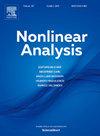Some qualitative and quantitative properties of weak solutions to mixed anisotropic and nonlocal quasilinear elliptic and doubly nonlinear parabolic equations
IF 1.3
2区 数学
Q1 MATHEMATICS
引用次数: 0
Abstract
This article is divided into two parts. In the first part, we examine the Brezis–Oswald problem involving a mixed anisotropic and nonlocal -Laplace operator. We establish results on existence, uniqueness, boundedness, and the strong maximum principle. Additionally, for certain mixed anisotropic and nonlocal -Laplace equations, we prove a Sturmian comparison theorem, establish comparison and nonexistence results, derive a weighted Hardy-type inequality, and analyze a system of singular mixed anisotropic and nonlocal -Laplace equations. A key component of our approach is the use of the Picone identity, which we adapt from the local and nonlocal cases. In the second part of the article, we focus on regularity estimates. In the elliptic setting, we establish a weak Harnack inequality and semicontinuity results. We also consider a class of doubly nonlinear mixed anisotropic and nonlocal parabolic equations, proving semicontinuity results and analyzing the pointwise behavior of solutions. These results rely on appropriate energy estimates, De Giorgi-type lemmas, and positivity expansions. Finally, we derive various energy estimates, which may be of independent interest.
混合各向异性和非局部拟线性椭圆型和双非线性抛物型方程弱解的一些定性和定量性质
本文分为两部分。在第一部分中,我们研究了涉及混合各向异性和非局部p-拉普拉斯算子的Brezis-Oswald问题。我们建立了关于存在性、唯一性、有界性和强极大值原理的结果。此外,对于某些混合各向异性和非局部p-Laplace方程,我们证明了一个Sturmian比较定理,建立了比较和不存在结果,导出了一个加权hardy型不等式,并分析了一个奇异的混合各向异性和非局部p-Laplace方程系统。我们方法的一个关键组成部分是Picone身份的使用,我们从本地和非本地情况中进行了调整。在本文的第二部分,我们将重点讨论正则性估计。在椭圆型环境下,我们建立了弱Harnack不等式和半连续性结果。我们还考虑了一类双非线性混合各向异性和非局部抛物型方程,证明了半连续性结果,并分析了解的点态行为。这些结果依赖于适当的能量估计、德乔尔吉型引理和正展开。最后,我们得出各种能量估计,这可能是独立的兴趣。
本文章由计算机程序翻译,如有差异,请以英文原文为准。
求助全文
约1分钟内获得全文
求助全文
来源期刊
CiteScore
3.30
自引率
0.00%
发文量
265
审稿时长
60 days
期刊介绍:
Nonlinear Analysis focuses on papers that address significant problems in Nonlinear Analysis that have a sustainable and important impact on the development of new directions in the theory as well as potential applications. Review articles on important topics in Nonlinear Analysis are welcome as well. In particular, only papers within the areas of specialization of the Editorial Board Members will be considered. Authors are encouraged to check the areas of expertise of the Editorial Board in order to decide whether or not their papers are appropriate for this journal. The journal aims to apply very high standards in accepting papers for publication.

 求助内容:
求助内容: 应助结果提醒方式:
应助结果提醒方式:


